Victory at Sea: Battle for the Pacific - First Thoughts
Howard is back after his adventures painting some Bolt Action for the store with a look at Warlord Games lates offering, Victory at Sea, and the Battle for the Pacific starter box!
Warlord Games has been busy once again, with a new game about to hit the streets called “Victory at Sea” (VaS). The name may be familiar to you because it’s a re-release of an older version published by Mongoose Games. I had heard rumours of VaS getting a rework several years ago and I was quite excited because I’ve played the Mongoose version and really enjoyed it.

It’s a pretty simple game that I found generally has reasonable outcomes, what’s often called a ‘beer and pretzels’ type of game. Not too much detail and granularity, but good game mechanics. In an early game we played years ago, we tried out the Bismarck vs. Hood scenario and on the second salvo from the Bismarck the Hood was hit by plunging fire in a magazine and exploded! In a crazy fluke our battle played out pretty much exactly as the engagement did in real life, which was really something to see.
I liked VaS so much that I started collecting 1/2400 GHQ miniatures and amassing decent fleets for the British, Germans and especially the US and Japanese for the Pacific theatre. I have all seven aircraft carriers that fought at Midway, and worked out how to base up the aircraft units in the game on small metal bases with fishing line holding up each aircraft (so they’d be flexible if bumped during a game).
Some of my 1/2400 GHQ ships collected for version 1 of Victory at Sea:
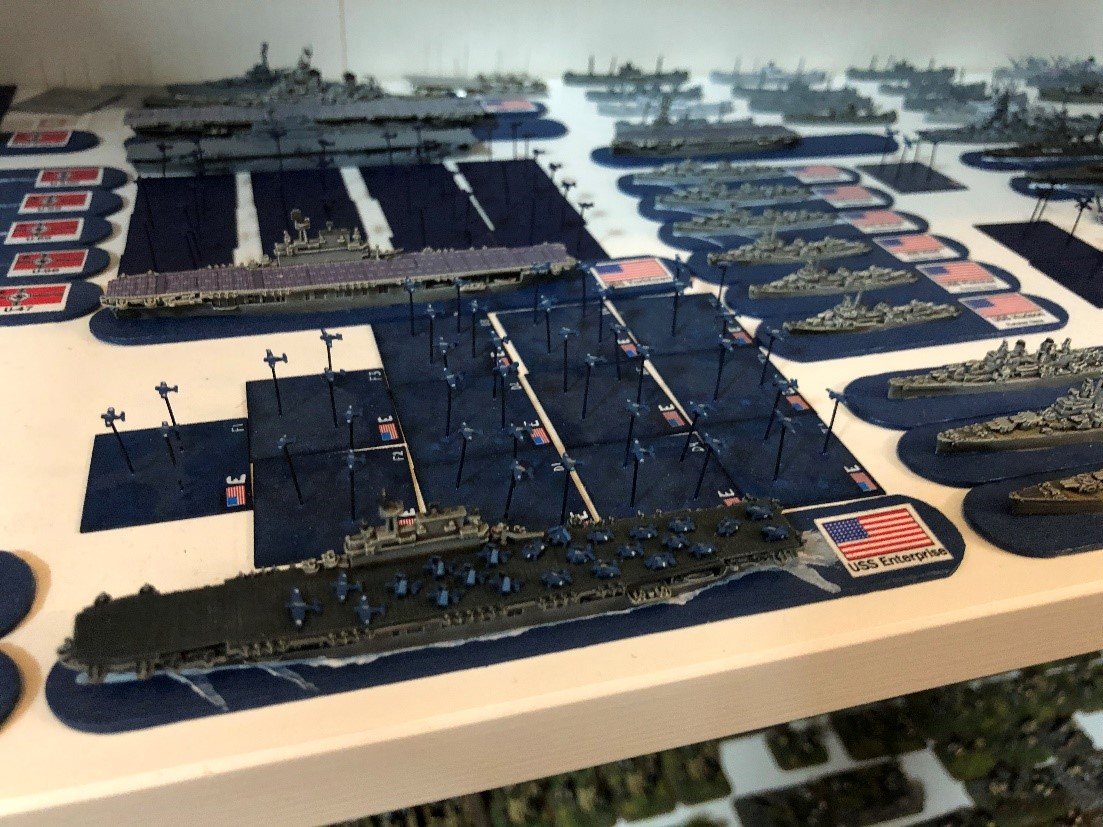
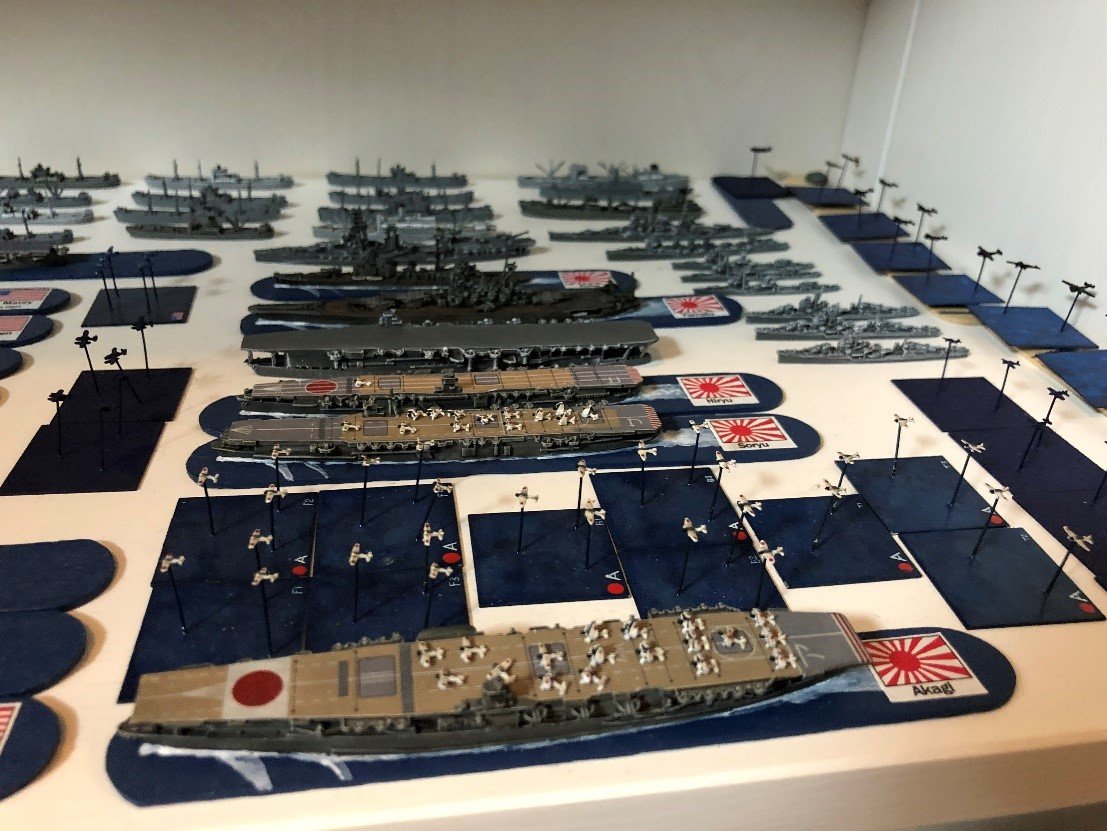
So I was looking forward to a version 2 of VaS, but over several years not much seemed to be happening and eventually I kind of gave up hope that it would ever see the light of day.
Enter Warlord Games and their announcement last year that they had picked up VaS and would be releasing the game themselves! Having played Warlord’s Cruel Seas and enjoyed it enough to buy into the Napoleonic take on those rules with their newer Black Seas game, I was both intrigued but also a little concerned to hear this news. I really liked how VaS played, I liked the extensive fleet lists across two books that I owned and of course I was pretty deeply invested in GHQ’s miniatures in 1/2400 scale.
Warlord started to share some news about their miniatures and candidly, I became a little more concerned. Their early releases showed 1/1800 scale ships on pretty large bases, and at first glance I thought they were a little overpowering. But you’ve got to keep an open mind about these things, and I always feel I need to be fair and give these companies a chance. Warlord has brought out some quality games, so I owe them a fair look here, I feel.
And of course, Warlord is obviously a miniature company and that’s how they want to drive sales, I get it. That explains why they chose a different scale from what’s already a well-established market. But I’m one of those players that also doesn’t mind experimenting with a set of rules in different scales (Battlefront’s “Flames of War” and “Team Yankee” games are sold with 15mm miniatures, but I’ve found they actually work even better in 6mm. Lucky for them I love the 15mm minis too!). So I’ve already got it in my mind that I could potentially use the 1/2400 minis I own. But until I play a few games I won’t know for sure, and there’s one key question that remains to be answered: Will Warlord sell the ship stats in a separate book or sell ship data cards? Or do you have to buy the models to get the data on each ship? I don’t know yet, but I’ve heard talk of books being published, so we’ll see what options we have.
And that brings us to today…
Kris at Sentry Box, knowing I’m an idiot and easily influenced, offered me the chance to paint up the demo set that the store had received. Sentry Box received a demo starter set called “Battle for the Pacific” with rules, models, ship data cards, dice, an ocean mat (printed on paper) and card-stock tokens and markers to punch-out.
True to form, I jumped at this chance to see the miniatures close up and get a chance to read through the rules.
First Thoughts on the Game Rules
A quick read-through of the rules confirms much of what I’d seen and read over the last year or so and also what I’d come to expect of a Warlord game. Once again Warlord is relying on their initiative system, which I enjoy. Players choose randomly who gets to go on a ship-by-ship basis, which adds an element of the unknown to a game. You can’t predict who gets to go next and I like that uncertainty!
The game is broken down into four phases; Initiative, Movement, Gunnery & End phases. Lots of focus falls on the gunnery phases, as you’d expect. I was pleased to see that armour can make a difference and the notion of “plunging fire” is still in the game, and ships can be crippled which has a pretty significant impact, obviously.
Shooting and several other rolls, like damage, are done with a 10-sided die (D10). As with VaS ver1, you can still give Orders to your ships, which can make all the difference in a battle. Several pages of the fairly thin rule book are given over to aircraft rules and then there’s a small section laying out special rules for the US Navy, Royal Navy, Imperial Japanese Navy and Kriegsmarine, with the Italian Regia Marina and French Marine Nationale mentioned.
Clearly by the title of the book we can realistically expect different books in the future focusing on different theatres. This was a store demo set, so it’s a little smaller than the actual game starter set which has an additional cruiser on each side and more destroyers.
As mentioned earlier, I’m very interested to see if Warlord will be putting out their ship data cards or a book with the stats for each ship, so that I can opt to use these new rules with different models or even cardboard tokens if anyone was so inclined. I love my miniatures though, no paper or cardboard games for me!
Looking over Warlord’s website also shows a pretty extensive list of pre-orders already posted for famous ships as well as fleet sets that look pretty impressive and frankly quite tempting. Each fleet box has a carrier, a battleship, several cruisers and destroyers and aircraft flights. The Royal Navy box includes Tribal-class destroyers too, the last of which, HMCS Haida, is currently on display in Hamilton, Ontario! (I had a birthday party on board Haida when I was kid growing up in Toronto, where it was docked for years, so naturally it’s in my GHQ collection and I have it in World of Warships too, LOL!)
There’s even a merchant convoy set (a soft spot for me for some weird reason), which implies perhaps a U-boat element in the future, but is also good for English Channel air attack scenarios, arctic convoy surface raiders and all kinds of other actions.
The Miniatures In the Demo Set
The miniatures in the set seem to be made up of resin ships moulded with an integral base. The bases have wave details sculpted on and the name and year of the ship (for larger ships) on the edge. Small ships like destroyers are just labelled with their class type. As I mentioned earlier, at first I was a little unsure about these bases. As I’ve read a couple other people’s thoughts on them, I have actually come around on the idea now.
You’ll notice with my own GHQ collection, I chose to put them on bases. This is to allow room for a ship’s name plate (which I created in MS Word and printed on colour laser printers) and to allow the ships to be handled without bending any of the white-metal details.
So many of us are already basing ship models, and here we don’t have to worry about that. The name is on the base already, you’ve got something to pick up without handling the model and you don’t have to add any water effects or sculpt any waves. It’s all done for us. So this is actually a net-positive when I view it this way.
The other important consideration is that with models of this size, scale isn’t related to what we’re doing on the table top. Using ships this big, we’d have to battle on a school gymnasium floor if we wanted to accurately reflect their ranges.
To give some context to what I’m saying, the biggest battleship ever to sail, Japan’s Yamato (and Musashi), could fire 25 miles – that’s 40 kilometres!! That means Yamato could basically fire a shell from the Calgary Tower and hit Okotoks!
Battleships could actually fire at targets they couldn’t even see, beyond the visible horizon from the ship. guided by spotter planes radioing back corrections. Naval aviation also soon becomes the dominant form of naval warfare in WWII, allowing fleets that never see other to fight decisive battles.
With such massive real-world ranges possible, ‘modern’ naval wargaming (WWI onward) is using ships more as markers on the table. They represent where the ship is on the table, not the true scale during the battle.
The rules speak to this in fact, and all measurements are conducted to the bridge of the ship, the control tower near the bow usually.
So once we’re able to disconnect scale from any meaningful part of the game play, it helps to just enjoy the models themselves and appreciate they’re just an abstract element, and having a nice little model on it’s own base with a name is helpful to keep track of which ship is where.
Back to the models now… Provided in the starter set are four destroyers and four cruisers; 2 each for the Japanese and Americans. Smaller ships like destroyers are single castings while larger ships have separate sprues for gun turrets and larger superstructure elements or fiddly castings.
Warlord has put enough detail into each ship to capture unique design features, meaning that nearly identical ships like Mogami and Kumano (both of the Mogami class) have separate sprue pieces named for each ship. This was more important for the US cruisers as well, which had distinctly different superstructure elements. So that’s a nice touch; these aren’t just cookie-cutter models for each class of ship. One piece missing on these models were the float planes they used for scouting and spotting. It would have been nice to have those on the sprue as they add a nice splash of colour to the models too.
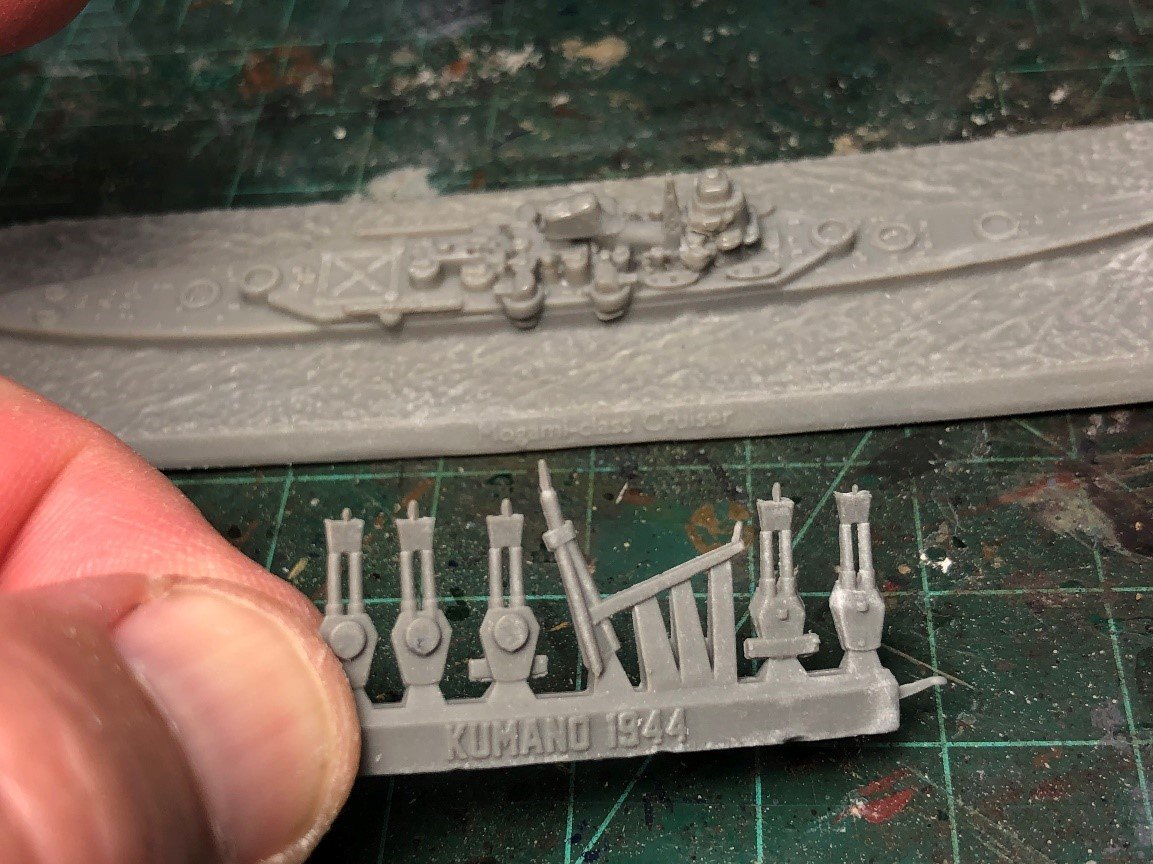
The plastic on the sprues is what I believe is known as “thermo-plastic”. This is a plastic that is a little soft and bendy, allowing it to bend without breaking. In a wargaming application the obvious advantage is that bumping the models won’t bend gun barrels or masts, which happens easily with white metal, and can cause paint to flake off.
Thermo plastic seems to get mixed reviews from wargamers, with some disliking it and others appreciating its features. I’ll say that it’s a bit of a pain to clean up mould separation lines from it, and filing it makes a fuzz that is a hard to scrape off. But I was struck by how many times, while handling the models and painting them, I knocked them about and it didn’t matter. It would have meant damage on my GHQ models but here it did no damage. The detail isn’t a sharp as you might get with GHQ castings, but they’re also good-looking models once painted up and I was impressed with the individuality of each ship (note Mogami has more life boats aft of the funnel, but Kumano has more AA mounts back there and no additional life boats).
I’m assuming the bases are a softer type of resin, and I realized this the hard way when I tried to straighten a slight warp on one of the US cruisers and snapped the whole model completely in half!! Whoops LOL!
But, a nice feature of resin is that a clean break also glues back together almost perfectly with CA glue and you can see I was able to repair it just fine.
If you do find you have a slight warp, try putting the model in very hot or boiling water for a short time, take it out and gently reshape it before it cools. That should do the trick.
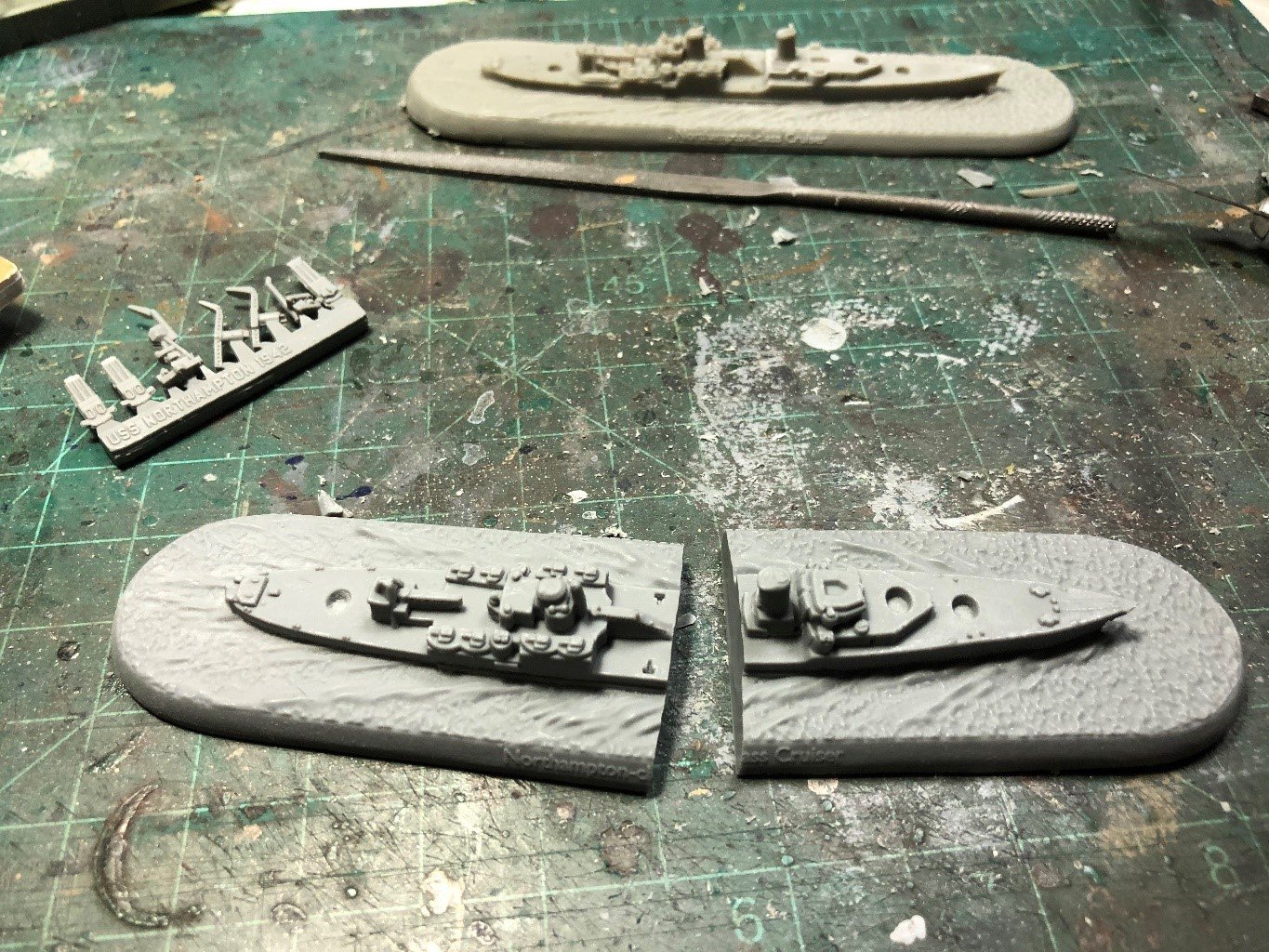
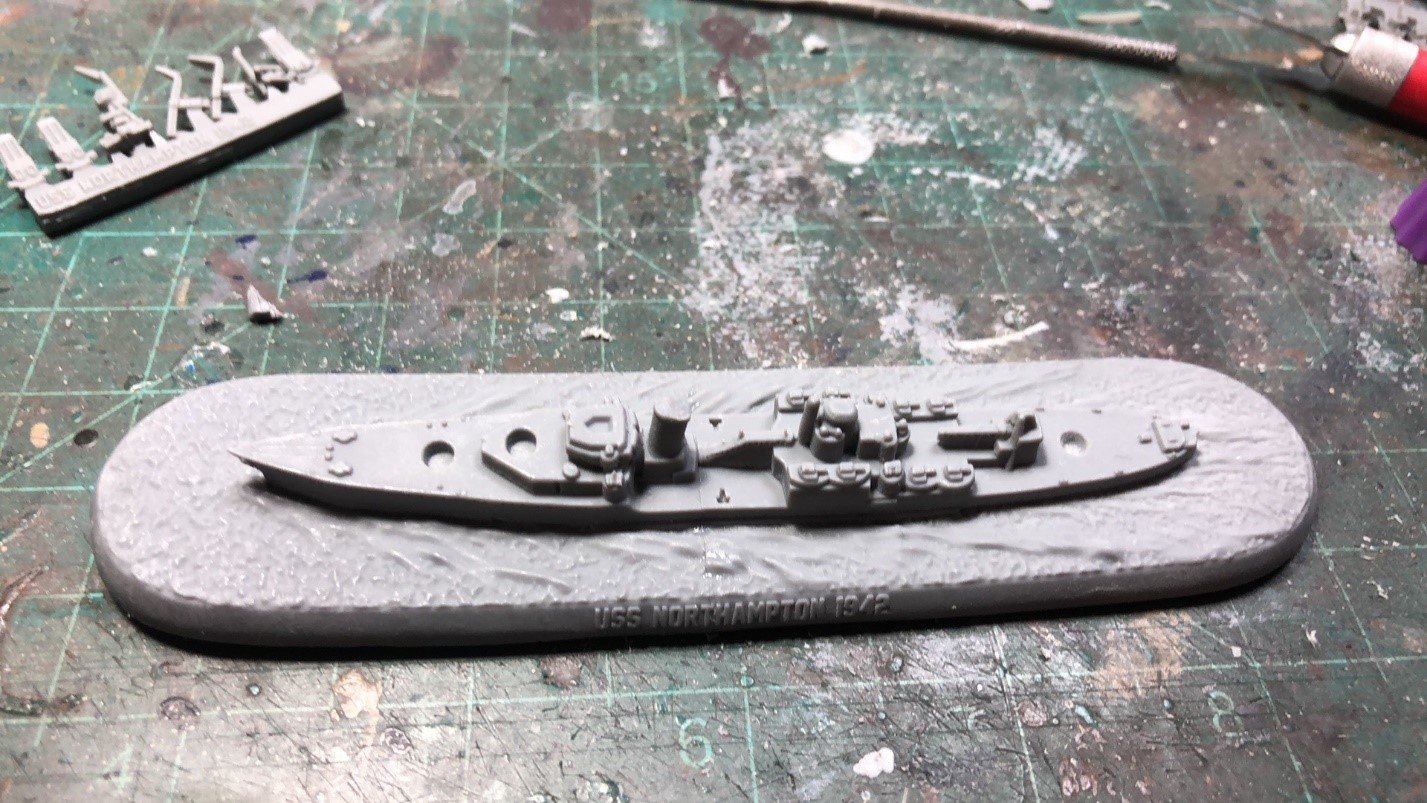
The bases have some mould plugs that need to be trimmed off and sanded smooth, and the ships have lots of little ‘nubs’ that need to be trimmed off with a sharp knife on the tops of virtually every little gun mount, mast, and raised detail.
Turrets and superstructure pieces get glued in and for each cruiser there’s either an aircraft crane or catapults that have to be glued on. If you’re ambitious, you could magnetize the gun turrets on the larger ships. I did not bother with that here, as this will be a store demo set.
After that, all eight ships are ready for paint.
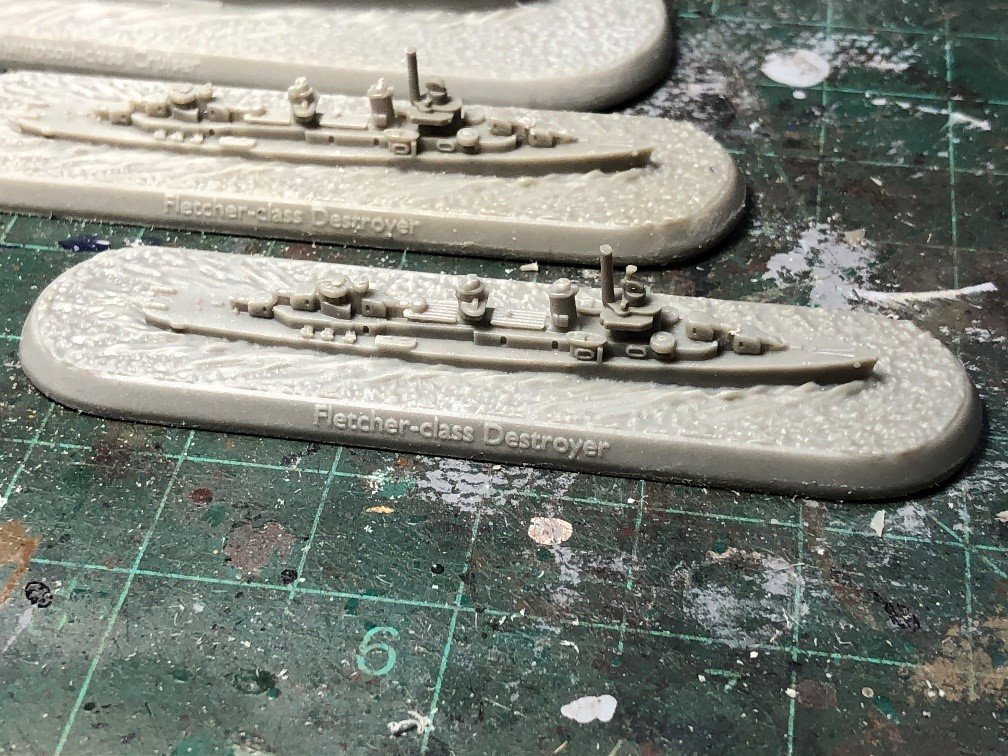
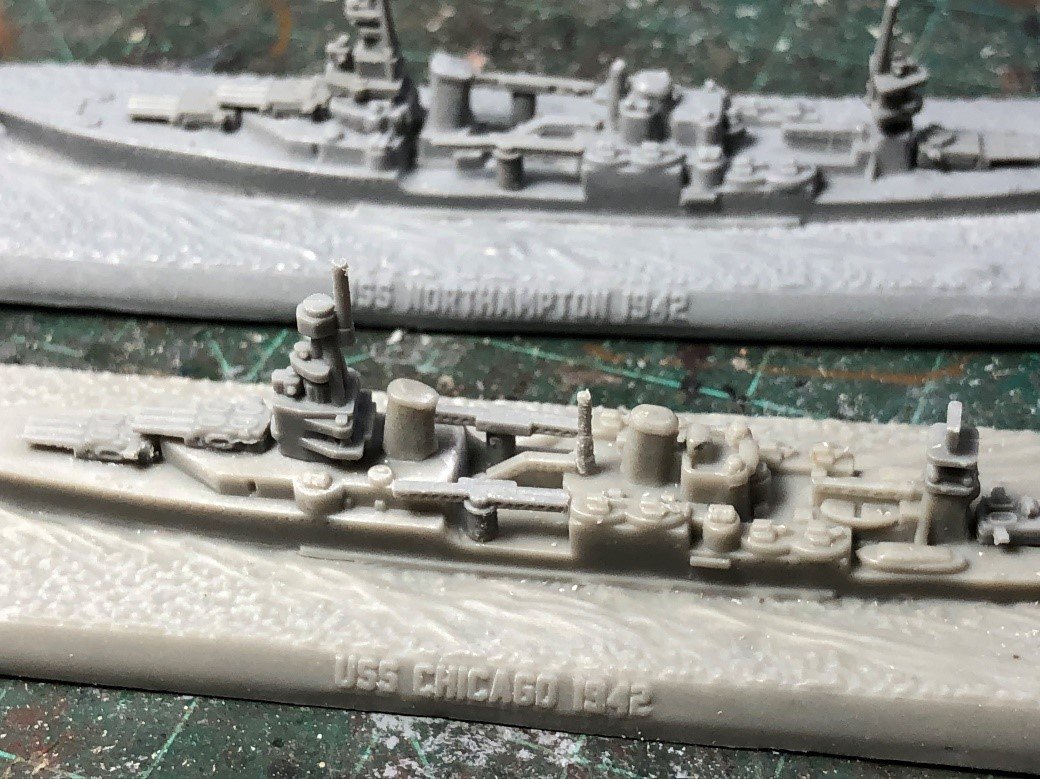
That's about it for my first thoughts on VIctory at Sea, check back soon to see how the actual painting turned out and thanks for reading!
- Howard Nason

